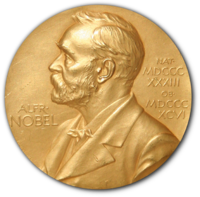
Photo from wikipedia
The scope of this study is to shed light on the determinants of the time gap between the publication of a Nobel discovery and the bestowment of the prize across… Click to show full abstract
The scope of this study is to shed light on the determinants of the time gap between the publication of a Nobel discovery and the bestowment of the prize across three science fields (Physics, Chemistry, and Medicine). The econometric evidence supports that the delay gap is inversely related to the age of the Laureate when the Nobel-worthy contribution was published in Physics and Chemistry but not in Medicine. An increase of the age of the researcher by one year leads to a reduction of the Nobel delay by almost three months on average while sharing the Prize for the same research delays the award by approximately 1.2 years. Lastly, important theoretical discoveries increase the delay by 3.3 years on average, while obtaining the last education degree a year later delays the Nobel Prize by 4.7 months on average.
Journal Title: Scientometrics
Year Published: 2022
Link to full text (if available)
Share on Social Media: Sign Up to like & get
recommendations!